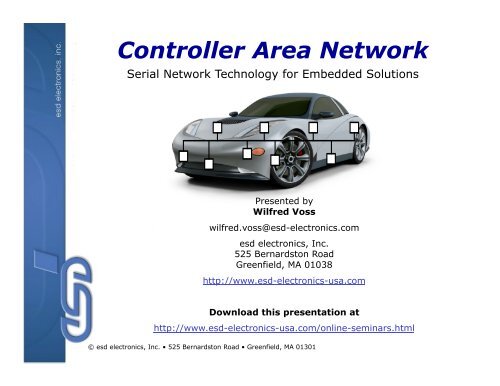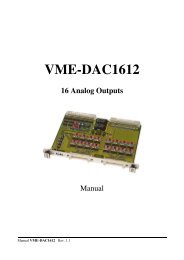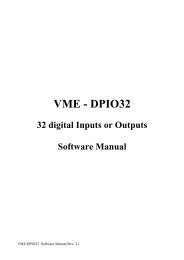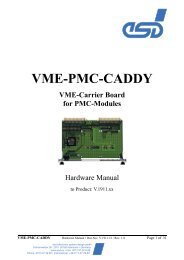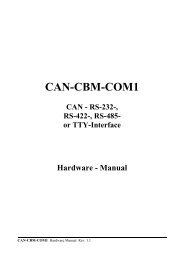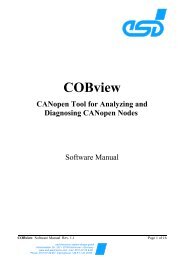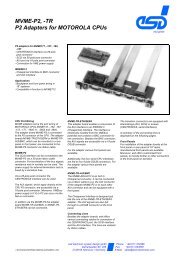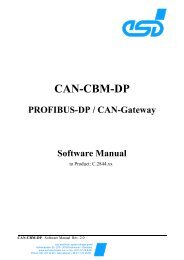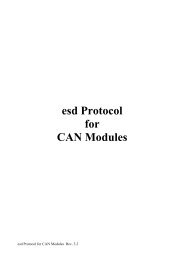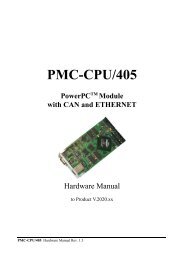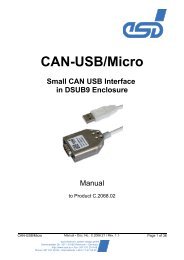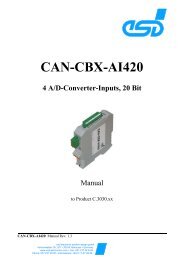Controller Area Network - esd electronics, Inc.
Controller Area Network - esd electronics, Inc.
Controller Area Network - esd electronics, Inc.
Create successful ePaper yourself
Turn your PDF publications into a flip-book with our unique Google optimized e-Paper software.
<strong>Controller</strong> <strong>Area</strong> <strong>Network</strong><br />
Serial <strong>Network</strong> Technology for Embedded Solutions<br />
Presented by<br />
Wilfred Voss<br />
wilfred.voss@<strong>esd</strong>-<strong>electronics</strong>.com<br />
<strong>esd</strong> <strong>electronics</strong>, <strong>Inc</strong>.<br />
525 Bernardston Road<br />
Greenfield, MA 01038<br />
http://www.<strong>esd</strong>-<strong>electronics</strong>-usa.com<br />
Download this presentation at<br />
http://www.<strong>esd</strong>-<strong>electronics</strong>-usa.com/online-seminars.html<br />
© <strong>esd</strong> <strong>electronics</strong>, <strong>Inc</strong>. • 525 Bernardston Road • Greenfield, MA 01301
<strong>Controller</strong> <strong>Area</strong> <strong>Network</strong> (CAN)<br />
1. Introduction<br />
2. General Aspects<br />
3. Protocol Features<br />
4. Hardware Features<br />
5. Development Aspects<br />
6. Higher Layer Protocols<br />
7. Literature<br />
© <strong>esd</strong> <strong>electronics</strong>, <strong>Inc</strong>. • 525 Bernardston Road • Greenfield, MA 01301<br />
Page 2
<strong>esd</strong> <strong>electronics</strong> provides:<br />
• CAN Hardware Interfaces – PCI, cPCI, VME, PMC, PC104, ISA, and more<br />
• CAN Gateways – USB, EtherNet, Bluetooth, IEEE488, and more<br />
• CAN Converters – CANopen, DeviceNet, Profibus, and more<br />
• CAN Embedded <strong>Controller</strong>s<br />
<strong>esd</strong> Product Line<br />
• Drivers and APIs for various operating systems<br />
• Free CAN Analyzer software – included with driver<br />
<strong>esd</strong> <strong>electronics</strong>, <strong>Inc</strong>.<br />
525 Bernardston Road<br />
Greenfield, MA 01301<br />
Tel.: 413-773-3170<br />
Fax: 413-773-3171<br />
http://www.<strong>esd</strong>-<strong>electronics</strong>-usa.com<br />
© <strong>esd</strong> <strong>electronics</strong>, <strong>Inc</strong>. • 525 Bernardston Road • Greenfield, MA 01301<br />
Page 3
Literature<br />
Literature on<br />
<strong>Controller</strong> <strong>Area</strong> <strong>Network</strong>,<br />
CANopen and SAE J1939<br />
© <strong>esd</strong> <strong>electronics</strong>, <strong>Inc</strong>. • 525 Bernardston Road • Greenfield, MA 01301 Page 4
<strong>Controller</strong> <strong>Area</strong> <strong>Network</strong> (CAN)<br />
Serial <strong>Network</strong> Technology for Embedded Solutions<br />
2. General Aspects<br />
© <strong>esd</strong> <strong>electronics</strong>, <strong>Inc</strong>. • 525 Bernardston Road • Greenfield, MA 01301<br />
Page 5
What is CAN – General Aspects<br />
• Serial <strong>Network</strong> Technology for Embedded Solutions<br />
• <strong>Network</strong> technology established among micro-controllers<br />
• Well suited for high speed/real-time applications<br />
• Replaces expensive Dual-Port RAM technology<br />
• CAN chips manufactured by Motorola, Philips, Intel, Infineon, ...<br />
• 600 Million CAN nodes used in 2007<br />
• Originally designed by Bosch for<br />
automotive industry<br />
• Became very popular in industrial<br />
automation<br />
© <strong>esd</strong> <strong>electronics</strong>, <strong>Inc</strong>. • 525 Bernardston Road • Greenfield, MA 01301 Page 6
What is CAN – Technical Aspects<br />
• High-integrity serial data communications bus for real-time<br />
applications<br />
• Designed for max. performance & reliability<br />
• Operates at data rates up to 1 Mbit/sec<br />
• Uses short messages – 8 bytes per message<br />
• Excellent error detection and fault confinement capabilities<br />
• Is an international standard: ISO 11898<br />
© <strong>esd</strong> <strong>electronics</strong>, <strong>Inc</strong>. • 525 Bernardston Road • Greenfield, MA 01301 Page 7
A Brief History of CAN - 1<br />
1983 Start of Bosch internal project to develop in-vehicle<br />
network<br />
1986 Official introduction of the CAN protocol<br />
1987 First CAN controller chips by Intel & Philips<br />
1991 Bosch publishes CAN specification 2.0<br />
1992 CAN in Automation (CiA) established<br />
1992 CAN Application Layer (CAL) protocol by CiA<br />
1992 First automobiles equipped with CAN (Mercedes Benz)<br />
1993 ISO 11898 standard published<br />
1994 First International CAN Conference (iCC)<br />
1994 Allen Bradley introduces DeviceNet<br />
1995 ISO 11898 amendment (extended frame format)<br />
1995 CANopen protocol introduced<br />
2000 Development of time-triggered CAN<br />
© <strong>esd</strong> <strong>electronics</strong>, <strong>Inc</strong>. • 525 Bernardston Road • Greenfield, MA 01301 Page 8
A Brief History of CAN - 2<br />
Number of Million CAN Nodes sold:<br />
© <strong>esd</strong> <strong>electronics</strong>, <strong>Inc</strong>. • 525 Bernardston Road • Greenfield, MA 01301 Page 9
CAN is used wherever two or more microprocessor units need to<br />
communicate with each other.<br />
• Passenger Cars (multiple separate CAN networks)<br />
• Trucks & Buses, Construction Vehicles, Agricultural Vehicles<br />
(SAE J1939 protocol)<br />
• Semiconductor Industry (Wafer Handlers, etc.)<br />
• Robotics, Motion Control Applications<br />
• Passenger/Cargo Trains (Brake Control, Wagon Communication)<br />
• Aircrafts (AC, Seat Adjustment)<br />
• Elevators (e.g. Otis)<br />
• Building Technologies (Light & Door Control Systems, Sensors, etc.)<br />
• Medical Equipment (X-Ray, CAT scanners, etc.)<br />
• Household Utilities (Coffee Machine, Washer, etc.)<br />
• Aerospace (Satellites)<br />
CAN Applications<br />
© <strong>esd</strong> <strong>electronics</strong>, <strong>Inc</strong>. • 525 Bernardston Road • Greenfield, MA 01301<br />
Page 10
CAN Applications<br />
© <strong>esd</strong> <strong>electronics</strong>, <strong>Inc</strong>. • 525 Bernardston Road • Greenfield, MA 01301 Page 11
• International Users and Manufacturers Organization<br />
• Develops, supports CAN Standards and CAN based higher layer<br />
protocols<br />
• All activities are based on CiA members’ interest<br />
http://www.can-cia.org<br />
CiA – CAN in Automation<br />
CAN Newsletter<br />
To subscribe log on to:<br />
http://www.can-cia.org/newsletter/<br />
© <strong>esd</strong> <strong>electronics</strong>, <strong>Inc</strong>. • 525 Bernardston Road • Greenfield, MA 01301 Page 12
<strong>Controller</strong> <strong>Area</strong> <strong>Network</strong> (CAN)<br />
Serial <strong>Network</strong> Technology for Embedded Solutions<br />
3. Protocol Features<br />
© <strong>esd</strong> <strong>electronics</strong>, <strong>Inc</strong>. • 525 Bernardston Road • Greenfield, MA 01301<br />
Page 13
Main Characteristics<br />
• Multi-Master Bus Access<br />
• Message Broadcasting<br />
• Message Priority (No Node IDs)<br />
• Limited Data Length (0…8 bytes)<br />
• 1 Mbit/sec Data Rate<br />
• Excellent Error Detection & Fault Confinement<br />
© <strong>esd</strong> <strong>electronics</strong>, <strong>Inc</strong>. • 525 Bernardston Road • Greenfield, MA 01301 Page 14
Main Benefit:<br />
Benefits of Using CAN<br />
• Physical and Data Link Layer implemented in Silicon<br />
• SW Development Engineer is not involved with writing<br />
protocol features<br />
• Low Cost Implementation<br />
ISO 11898 7-Layer Reference<br />
Be aware! Whenever you attempt to add software functions between the CAN Data Link Layer and the<br />
Application Layer, you will be adding functionalities that are already covered by off-the-shelf available higher<br />
layer protocols such as CANopen and DeviceNet.<br />
© <strong>esd</strong> <strong>electronics</strong>, <strong>Inc</strong>. • 525 Bernardston Road • Greenfield, MA 01301 Page 15
Message Frames<br />
• Data Frame – Broadcasts a message to the CAN bus<br />
• Remote Frame – Requests transmission of message<br />
• Error Frame – Signals error condition<br />
• Overload Frame – Special Error Frame<br />
© <strong>esd</strong> <strong>electronics</strong>, <strong>Inc</strong>. • 525 Bernardston Road • Greenfield, MA 01301 Page 16
Message Broadcasting with Data Frames<br />
• Node A transmits a message<br />
• Nodes B, C and D receive the message<br />
• Nodes B and D accept the message, Node C declines<br />
© <strong>esd</strong> <strong>electronics</strong>, <strong>Inc</strong>. • 525 Bernardston Road • Greenfield, MA 01301 Page 17
Message Request with Remote Frames - 1<br />
• Node A sends a remote frame (request)<br />
• Node B, C, D receive message<br />
• Node D accepts, Nodes B & C decline message<br />
© <strong>esd</strong> <strong>electronics</strong>, <strong>Inc</strong>. • 525 Bernardston Road • Greenfield, MA 01301 Page 18
Message Request with Remote Frames - 2<br />
• Node D sends requested message<br />
• Nodes A, B, C receive requested message<br />
• Nodes A, B accept requested message, Node C declines<br />
© <strong>esd</strong> <strong>electronics</strong>, <strong>Inc</strong>. • 525 Bernardston Road • Greenfield, MA 01301 Page 19
• Data Frame<br />
• Remote Frame<br />
• Error/Overload Frame<br />
Message Frame Format - 1<br />
© <strong>esd</strong> <strong>electronics</strong>, <strong>Inc</strong>. • 525 Bernardston Road • Greenfield, MA 01301 Page 20
Message Frame Format - 2<br />
© <strong>esd</strong> <strong>electronics</strong>, <strong>Inc</strong>. • 525 Bernardston Road • Greenfield, MA 01301 Page 21
Extended CAN Protocol<br />
• Standard Format: 11 Bit Message Identifier<br />
• Extended Format: 29 Bit Message Identifier<br />
• Both formats, Standard and Extended, may co-exist on the same CAN<br />
bus<br />
• The distinction between both formats is managed by “Identifier<br />
Extension Bit” (IDE)<br />
© <strong>esd</strong> <strong>electronics</strong>, <strong>Inc</strong>. • 525 Bernardston Road • Greenfield, MA 01301 Page 22
Bus Arbitration Principle<br />
• Bit wise arbitration across the Arbitration Field<br />
• Dominant Bus Level = 0, Recessive Bus Level = 1<br />
© <strong>esd</strong> <strong>electronics</strong>, <strong>Inc</strong>. • 525 Bernardston Road • Greenfield, MA 01301 Page 23
Dominant/Recessive Bus Level<br />
Node Output and Resulting Bus Level<br />
© <strong>esd</strong> <strong>electronics</strong>, <strong>Inc</strong>. • 525 Bernardston Road • Greenfield, MA 01301 Page 24
Bit Monitoring<br />
• Each transmitting node monitors the Bit level on the bus,<br />
compares it to transmitted level.<br />
• Used during arbitration process.<br />
• Provides immediate detection of all bus-wide and local transmission<br />
errors.<br />
© <strong>esd</strong> <strong>electronics</strong>, <strong>Inc</strong>. • 525 Bernardston Road • Greenfield, MA 01301 Page 25
Maximum Bus Length<br />
• Bus Length is limited due to Bit Monitoring<br />
(Signal Propagation Time)<br />
© <strong>esd</strong> <strong>electronics</strong>, <strong>Inc</strong>. • 525 Bernardston Road • Greenfield, MA 01301 Page 26
Bus Arbitration Principle<br />
© <strong>esd</strong> <strong>electronics</strong>, <strong>Inc</strong>. • 525 Bernardston Road • Greenfield, MA 01301 Page 27
Main Rules of Bus Arbitration<br />
Bus Arbitration Principle<br />
• Bus is considered idle after transmitted message plus Intermission<br />
Field<br />
• Node that transmits message with lowest ID (highest priority) wins<br />
arbitration, continues to transmit. Competing nodes switch to<br />
receiving mode.<br />
• Nodes that lost arbitration will start new arbitration as soon as bus is<br />
free for access again => No message gets lost<br />
© <strong>esd</strong> <strong>electronics</strong>, <strong>Inc</strong>. • 525 Bernardston Road • Greenfield, MA 01301 Page 28
Bit Coding<br />
Data Transfer Synchronization<br />
• Bit coding according to Non-Return-to-Zero principle<br />
• NRZ provides highest transport capacity<br />
• Constant Bit level over Bit time<br />
• Insufficient signal edges for synchronization of Bit stream<br />
• “Bit Stuffing” required<br />
© <strong>esd</strong> <strong>electronics</strong>, <strong>Inc</strong>. • 525 Bernardston Road • Greenfield, MA 01301 Page 29
Bit Stuffing<br />
Data Transfer Synchronization<br />
• Sender inserts complementary Bit (“Stuff Bit”) after 5 successive Bits<br />
of same polarity<br />
• Receiver filters the complementary Bit<br />
1. Bit sequence to be<br />
transmitted<br />
2. Transmitted Bit sequence on<br />
bus after bit stuffing<br />
3. Bit sequence at receiver<br />
after filtering Stuff Bit<br />
© <strong>esd</strong> <strong>electronics</strong>, <strong>Inc</strong>. • 525 Bernardston Road • Greenfield, MA 01301 Page 30
Frame Length Due to Bit Stuffing<br />
• Frame length varies due to bit stuffing<br />
• Based on 11-Bit Identifier<br />
Data Field<br />
0 Bytes<br />
Data Field<br />
8 Bytes<br />
No bit stuffing 47 bits 111 bits<br />
Max. bit stuffing<br />
(worst case scenario)<br />
55 bits 135 bits<br />
Average bit stuffing 49 bits 114 bits<br />
• Average bit stuffing determined per mathematical model<br />
© <strong>esd</strong> <strong>electronics</strong>, <strong>Inc</strong>. • 525 Bernardston Road • Greenfield, MA 01301 Page 31
Bit Monitoring<br />
• When exactly does a receiving CAN node read the<br />
bit information ?<br />
Bit Rate [kBit/<br />
sec]<br />
Nominal Bit-Time<br />
[µsec]<br />
1000 1<br />
500 2<br />
250 4<br />
125 8<br />
© <strong>esd</strong> <strong>electronics</strong>, <strong>Inc</strong>. • 525 Bernardston Road • Greenfield, MA 01301 Page 32
Bit Monitoring<br />
• Partitioning of CAN Bit Time into Four Segments<br />
Sync_Seg: Signal edge is expected here. Any deviation<br />
will affect Phase Buffer lengths.<br />
Prop_Seg: Compensates for signal propagation times<br />
within the network.<br />
Phase_Seg1/2: Compensate for signal edge phase<br />
errors by adjusting their length.<br />
Resynchronization Jump Width: Defines the upper<br />
limit to adjust phase buffer lengths.<br />
© <strong>esd</strong> <strong>electronics</strong>, <strong>Inc</strong>. • 525 Bernardston Road • Greenfield, MA 01301 Page 33
• Bit Monitoring<br />
Error Detection Method<br />
Each transmitting node monitors the Bit level on the bus, compares it to<br />
transmitted level. Provides immediate detection of all bus-wide and local<br />
transmission errors.<br />
• Stuff Error<br />
More than 5 Bits of same polarity outside of “bit-stuffed” segment<br />
• CRC Error<br />
Comparison of received CRC sequence and calculated CRC. Provides<br />
detection of local receiver errors.<br />
• Form Error<br />
Violation of fixed format Bit fields<br />
• Acknowledgement Error<br />
Transmitted message receives no acknowledgement. ACK confirms only<br />
the successful transmission. Is used for error confinement.<br />
© <strong>esd</strong> <strong>electronics</strong>, <strong>Inc</strong>. • 525 Bernardston Road • Greenfield, MA 01301 Page 34
Error Detection Analysis<br />
Probability of non-detected faulty CAN messages<br />
Example:<br />
• 1 Bit error each 0.7 sec<br />
• 500 kBit/sec<br />
• 8 h/day<br />
• 365 days/year<br />
Residual Error Probability :<br />
1 undetected error in 1000 years<br />
© <strong>esd</strong> <strong>electronics</strong>, <strong>Inc</strong>. • 525 Bernardston Road • Greenfield, MA 01301 Page 35
Error Frame<br />
Basic Error Frame<br />
More “realistic” Error Frame<br />
Error Detection<br />
Error Recovery Time = Error Flag + Error Delimiter + Intermission Field = 12 + 8 + 3 = 23 Bits<br />
© <strong>esd</strong> <strong>electronics</strong>, <strong>Inc</strong>. • 525 Bernardston Road • Greenfield, MA 01301 Page 36
Fault Confinement<br />
• Guarantees proper network operation even in cases where<br />
malfunctioning nodes produce continuous error condition<br />
• CAN error detection can pinpoint to “perpetrator”<br />
• Distinction between temporary and permanent node failures<br />
• Identification and removal (self-retirement) of malfunctioning nodes<br />
from the bus<br />
© <strong>esd</strong> <strong>electronics</strong>, <strong>Inc</strong>. • 525 Bernardston Road • Greenfield, MA 01301 Page 37
Transmit/Receive Errors<br />
Possible error scenarios in a CAN network:<br />
1. Transmit Error<br />
• A transmitting node sends a faulty message<br />
• ALL receiving nodes in the network respond with an error frame<br />
• Through “majority vote” the transmitting node is being flagged as<br />
the “perpetrator”<br />
2. Receive Error<br />
• A transmitting node send a perfectly good message<br />
• Only ONE node in the network responds with an error frame<br />
• Through “majority vote” the error reporting node is being flagged as<br />
the “perpetrator”<br />
© <strong>esd</strong> <strong>electronics</strong>, <strong>Inc</strong>. • 525 Bernardston Road • Greenfield, MA 01301 Page 38
CAN Node Error States<br />
Fault Confinement<br />
© <strong>esd</strong> <strong>electronics</strong>, <strong>Inc</strong>. • 525 Bernardston Road • Greenfield, MA 01301 Page 39
<strong>Controller</strong> <strong>Area</strong> <strong>Network</strong> (CAN)<br />
Serial <strong>Network</strong> Technology for Embedded Solutions<br />
4. Hardware Features<br />
© <strong>esd</strong> <strong>electronics</strong>, <strong>Inc</strong>. • 525 Bernardston Road • Greenfield, MA 01301<br />
Page 40
Bus Medium<br />
• Physical media must support “dominant” and “recessive” bus level.<br />
Dominant level always overrules recessive level, especially during bus<br />
arbitration.<br />
• Two-wire bus terminated with line impedance to avoid signal<br />
reflections<br />
© <strong>esd</strong> <strong>electronics</strong>, <strong>Inc</strong>. • 525 Bernardston Road • Greenfield, MA 01301 Page 41
Bus Topology<br />
Bus Topology according to ISO 11898<br />
© <strong>esd</strong> <strong>electronics</strong>, <strong>Inc</strong>. • 525 Bernardston Road • Greenfield, MA 01301 Page 42
Bus Level<br />
Bus Levels according to ISO 11898<br />
© <strong>esd</strong> <strong>electronics</strong>, <strong>Inc</strong>. • 525 Bernardston Road • Greenfield, MA 01301 Page 43
Bus Level<br />
Bus Levels according to ISO 11898<br />
© <strong>esd</strong> <strong>electronics</strong>, <strong>Inc</strong>. • 525 Bernardston Road • Greenfield, MA 01301 Page 44
Bus Connection<br />
© <strong>esd</strong> <strong>electronics</strong>, <strong>Inc</strong>. • 525 Bernardston Road • Greenfield, MA 01301 Page 45
Wiring and Connections<br />
Pin Signal Description<br />
1 - Reserved<br />
2 CAN_L CAN_L bus line (dominant low)<br />
3 CAN_GND CAN Ground<br />
4 - Reserved<br />
5 CAN_SHLD Optional CAN shield<br />
6 GND Optional CAN Ground<br />
7 CAN_H CAN_H bus line (dominant high)<br />
8 - Reserved (error line)<br />
9 CAN_V+ Optional CAN external positive supply<br />
© <strong>esd</strong> <strong>electronics</strong>, <strong>Inc</strong>. • 525 Bernardston Road • Greenfield, MA 01301 Page 46
Two different types of CAN applications:<br />
• Stand-Alone CAN <strong>Controller</strong><br />
CAN <strong>Controller</strong> Chips<br />
• Microprocessor with integrated CAN <strong>Controller</strong><br />
Many major semiconductor manufacturers, such as Motorola,<br />
Philips, Intel, Infineon, and many more, sell CAN chips.<br />
Most semiconductor manufacturers who usually integrated a UART<br />
with their microprocessor design, in order to support serial<br />
communication for RS 232/485, nowadays tend to integrate CAN<br />
instead.<br />
© <strong>esd</strong> <strong>electronics</strong>, <strong>Inc</strong>. • 525 Bernardston Road • Greenfield, MA 01301 Page 47
<strong>Controller</strong> <strong>Area</strong> <strong>Network</strong> (CAN)<br />
Serial <strong>Network</strong> Technology for Embedded Solutions<br />
5. Development Aspects<br />
© <strong>esd</strong> <strong>electronics</strong>, <strong>Inc</strong>. • 525 Bernardston Road • Greenfield, MA 01301<br />
Page 48
Maximum Bus Length<br />
• Bus Length is limited due to Bit Monitoring<br />
(Signal Propagation Time)<br />
© <strong>esd</strong> <strong>electronics</strong>, <strong>Inc</strong>. • 525 Bernardston Road • Greenfield, MA 01301 Page 49
Special Application Aspects<br />
CAN protocol standard does not include “Inhibit Time”<br />
Problem: What happens when a high-priority message ID jams the bus<br />
with a constant stream of messages, e.g. event-triggered sensor<br />
readings?<br />
“Inhibit Time” must be implemented into the application, unless you<br />
use a higher layer protocol such as CANopen or DeviceNet.<br />
Remember! Whenever you attempt to add software functions between the CAN Data Link<br />
Layer and the Application Layer, you will be adding functionalities that are already covered by<br />
off-the-shelf available higher layer protocols such as CANopen and DeviceNet.<br />
© <strong>esd</strong> <strong>electronics</strong>, <strong>Inc</strong>. • 525 Bernardston Road • Greenfield, MA 01301<br />
Page 50
What you need is…<br />
CAN Development Tools<br />
• The “regular” tools such as cross-compiler, emulator, etc.<br />
• CAN Hardware Interface (Starter Kit)<br />
© <strong>esd</strong> <strong>electronics</strong>, <strong>Inc</strong>. • 525 Bernardston Road • Greenfield, MA 01301 Page 51
What you need is…<br />
• CAN API for your own programming (should be included with HW)<br />
• CAN “Analyzer” Software<br />
CAN Development Tools<br />
© <strong>esd</strong> <strong>electronics</strong>, <strong>Inc</strong>. • 525 Bernardston Road • Greenfield, MA 01301 Page 52
CAN Development Tools<br />
CANreal – Monitoring & Recording<br />
© <strong>esd</strong> <strong>electronics</strong>, <strong>Inc</strong>. • 525 Bernardston Road • Greenfield, MA 01301 Page 53
CAN Development Tools<br />
CANplot – Graphical display of CAN data<br />
© <strong>esd</strong> <strong>electronics</strong>, <strong>Inc</strong>. • 525 Bernardston Road • Greenfield, MA 01301 Page 54
CAN Development Tools<br />
CANrepro – Re-play of pre-recorded messages<br />
© <strong>esd</strong> <strong>electronics</strong>, <strong>Inc</strong>. • 525 Bernardston Road • Greenfield, MA 01301 Page 55
CAN Development Tools<br />
CANscript – Python scripting tool<br />
© <strong>esd</strong> <strong>electronics</strong>, <strong>Inc</strong>. • 525 Bernardston Road • Greenfield, MA 01301 Page 56
CAN Development Tools<br />
COBview – Analysis and diagnostics of CANopen nodes<br />
© <strong>esd</strong> <strong>electronics</strong>, <strong>Inc</strong>. • 525 Bernardston Road • Greenfield, MA 01301 Page 57
<strong>Controller</strong> <strong>Area</strong> <strong>Network</strong> (CAN)<br />
Serial <strong>Network</strong> Technology for Embedded Solutions<br />
6. Higher Layer Protocols<br />
© <strong>esd</strong> <strong>electronics</strong>, <strong>Inc</strong>. • 525 Bernardston Road • Greenfield, MA 01301<br />
Page 58
Why Higher Layer Protocols…?<br />
Higher Layer Protocols<br />
• Data Transport of more than 8 bytes<br />
• Embedded Systems require appropriate communication model based<br />
on Master/Slave configuration<br />
• <strong>Network</strong> Management (<strong>Network</strong> Start-Up, Node Monitoring, Node<br />
Synchronization, etc.)<br />
© <strong>esd</strong> <strong>electronics</strong>, <strong>Inc</strong>. • 525 Bernardston Road • Greenfield, MA 01301 Page 59
CANopen<br />
• Suited for embedded applications<br />
• Was originally designed for motion control<br />
• Developed/Maintained by CAN-in-Automation User Group<br />
• Manufacturer-Independent Protocol<br />
http://www.can-cia.org<br />
DeviceNet<br />
• Suited for industrial applications (floor automation)<br />
• Developed by Allen Bradley/Rockwell<br />
• Maintained by Open DeviceNet Vendor Association (ODVA)<br />
• Standard “controlled” by Allen Bradley/Rockwell<br />
http://www.odva.org<br />
SAE J 1939<br />
• Communication for vehicle networks (trucks, buses, etc.)<br />
• Standard developed by Society of Automotive Engineers (SAE)<br />
http://www.sae.org<br />
Higher Layer Protocols<br />
© <strong>esd</strong> <strong>electronics</strong>, <strong>Inc</strong>. • 525 Bernardston Road • Greenfield, MA 01301 Page 60
MilCAN<br />
http://milcan.org<br />
© <strong>esd</strong> <strong>electronics</strong>, <strong>Inc</strong>. • 525 Bernardston Road • Greenfield, MA 01301 Page 61
CAN-in-Automation (CiA)<br />
More Info on CAN<br />
http://www.can-cia.org<br />
Open DeviceNet Vendor Association (ODVA)<br />
http://www.odva.org<br />
Society of Automotive Engineers (SAE)<br />
http://www.sae.org<br />
Robert Bosch GmbH<br />
http://www.semiconductors.bosch.de<br />
© <strong>esd</strong> <strong>electronics</strong>, <strong>Inc</strong>. • 525 Bernardston Road • Greenfield, MA 01301 Page 62
<strong>Controller</strong> <strong>Area</strong> <strong>Network</strong> (CAN)<br />
Serial <strong>Network</strong> Technology for Embedded Solutions<br />
7. Literature<br />
© <strong>esd</strong> <strong>electronics</strong>, <strong>Inc</strong>. • 525 Bernardston Road • Greenfield, MA 01301<br />
Page 63
CAN Literature<br />
http://can.copperhillmedia.com/<br />
© <strong>esd</strong> <strong>electronics</strong>, <strong>Inc</strong>. • 525 Bernardston Road • Greenfield, MA 01301 Page 64
CANopen Literature<br />
http://canopen.copperhillmedia.com/<br />
© <strong>esd</strong> <strong>electronics</strong>, <strong>Inc</strong>. • 525 Bernardston Road • Greenfield, MA 01301 Page 65
J1939 Literature<br />
http://j1939.copperhillmedia.com/<br />
© <strong>esd</strong> <strong>electronics</strong>, <strong>Inc</strong>. • 525 Bernardston Road • Greenfield, MA 01301 Page 66
<strong>Controller</strong> <strong>Area</strong> <strong>Network</strong><br />
Serial <strong>Network</strong> Technology for Embedded Solutions<br />
Presented by<br />
Wilfred Voss<br />
wilfred.voss@<strong>esd</strong>-<strong>electronics</strong>.com<br />
<strong>esd</strong> <strong>electronics</strong>, <strong>Inc</strong>.<br />
525 Bernardston Road<br />
Greenfield, MA 01038<br />
http://www.<strong>esd</strong>-<strong>electronics</strong>-usa.com<br />
Download this presentation at<br />
http://www.<strong>esd</strong>-<strong>electronics</strong>-usa.com/online-seminars.html<br />
© <strong>esd</strong> <strong>electronics</strong>, <strong>Inc</strong>. • 525 Bernardston Road • Greenfield, MA 01301


